

Feeling overwhelmed by the complexity of policy writing? Need help communicating your ideas effectively and bringing clarity to the chaos? Fear not! Our comprehensive guide is here to ease your pain and equip you with the tools you need to master the art of policy writing.
Policies help promote consistency and productivity while fostering an organized working environment. From startups to well-established industry giants, the unique art of policy writing is a highly underestimated skill.
Well-crafted policies are key to unlocking your workforce’s potential and fostering a positive organizational culture. This article highlights the key steps and best practices for creating comprehensive policies that your fantastic workforce can easily embrace. These policies will embody your organization’s vision and values and breathe some life into your pursuit of excellence. You can sign up to SweetProcess right now to create yours!

Here’s the step-by-step guide for writing the policy.
Thorough internal research is essential before creating policies. Understand the organization’s mission, values, and objectives. Identify existing policies to avoid duplication or contradictions.
Review relevant data, statistics, and past incidents to grasp the context and potential risks associated with the policy you plan to create. Engage with relevant stakeholders, such as department heads and employees, to gather insights and consider their needs.
Based on the research, identify the policies that need to be established or updated. Categorize them into clear and distinct areas, such as human resources, cybersecurity, data protection, or workplace safety. Prioritize policies based on urgency, importance, or legal requirements. Start with critical policies before moving on to those of lesser significance.
Each policy should have specific elements to ensure clarity and effectiveness. These typically include:
a. Policy Purpose and Scope
Clearly state the policy’s purpose and define its scope. Explain why the policy is essential and who it applies to within the organization. This section sets the context for the entire policy.
Outline the roles and responsibilities of individuals or departments involved in implementing and enforcing the policy. This section helps avoid ambiguity and ensures accountability.
c. Policy Statement
Present the policy’s primary principles and rules concisely. Use clear language to avoid misinterpretation and make it easy for readers to understand.
d. Procedures and Guidelines
If necessary, include detailed procedures or guidelines that help employees adhere to the policy effectively. Use bullet points or numbered lists to improve readability.
e. Compliance and Consequences
Explain the consequences of policy violations and the organization’s steps to ensure compliance. This section emphasizes the policy’s importance and encourages adherence.
For each identified policy document, develop content that addresses the key elements. Be precise and concise, and avoid ambiguous language. Use clear terminology and avoid jargon. Ensure that the policy is aligned with the organization’s culture and tone. Seek feedback from subject matter experts and relevant stakeholders to ensure accuracy and completeness.
While conciseness is crucial, certain policies may require additional information or context to ensure stakeholders fully comprehend their implications. Create supplementary materials like FAQs, examples, or implementation guidelines. These supporting documents can help employees understand how the policy applies to specific scenarios, promoting better compliance.
Once the initial draft is ready, conduct a thorough review. Look for inconsistencies, ambiguities, or potential gaps in the policy. Seek feedback from different departments and levels of the organization to gain diverse perspectives. Revise the policy accordingly and ensure it aligns with the organization’s language and style.
Consider formatting the policy in a user-friendly manner. Use headings, bullet points, and numbering to enhance readability. Employ a logical flow that makes it easy for readers to navigate the policy.
Before finalizing the policy, obtain necessary approvals from relevant stakeholders or management. Ensure that all changes and feedback are incorporated into the final version. Once approved, communicate the policy effectively to all employees and relevant parties. To ensure maximum visibility, use multiple channels such as emails, internal communication apps, intranet, or company-wide meetings.

SweetProcess is a powerful tool that can streamline and simplify the process of policy writing and management for businesses and organizations. This section will explore three aspects of using SweetProcess: manual policy writing, automatic policy generation with SweetAI, and the management of existing policies.
We will provide step-by-step instructions, screenshots, and video walkthroughs to help you understand how to use SweetProcess effectively.
You may decide to write your policy manually using SweetProcess. Our tool offers a user-friendly interface that makes the process seamless.
Step 1: Log in to SweetProcess
Create a new SweetProcess account if you don’t have one before now, or log in to the account if you already have one.
Once logged in, you’ll be taken to the dashboard; click the “Policies” tab.

Step 2: Create a New Policy

Click the “+ Create Policy” button to create a new policy.
Give the policy a title.

Add the policy to one of your teams or more.
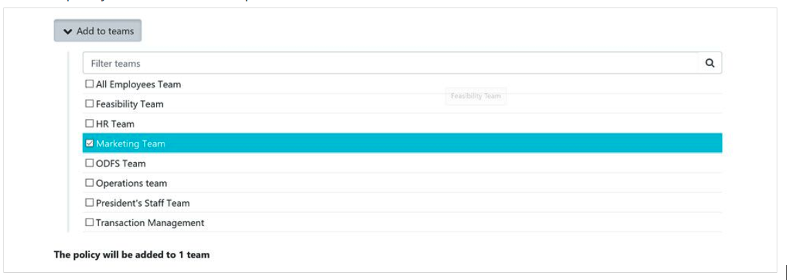
Click the “Continue” button.

Click on the space beneath to edit the policy.

Step 3: Define Policy Steps
Click on the “Add Step” button to add the first step to your policy.
Give the step a title and a brief description that explains what it entails.
You can also add images, videos, or documents to clarify the step further.
Step 4: Review and Publish
Review your policy once you’ve completed all the necessary steps.
When drafting the policy document, click “Approve” in the upper right corner of the page to approve it and make it live.

You can request permission by clicking the “Request Approval” button, as shown below, even if you cannot approve the policy.

Note: Any process or policy you create in SweetProcess may be embedded on any website you choose, and any changes you make will be instantly updated.
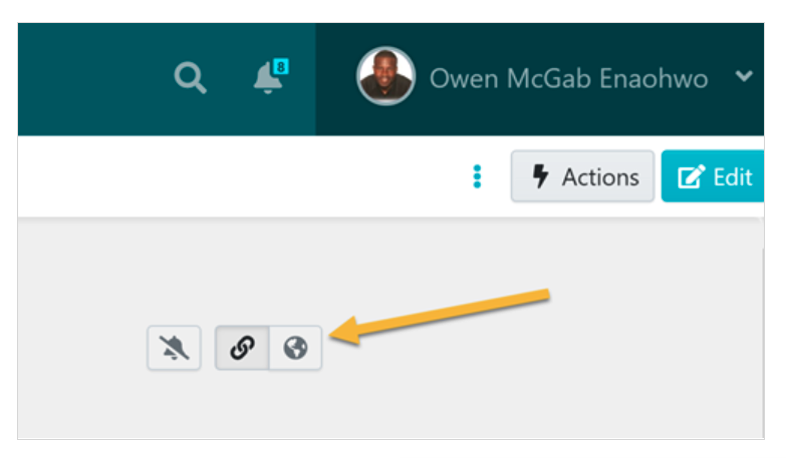

SweetProcess offers an exciting feature called SweetAI, which utilizes artificial intelligence to automate policy writing based on predefined templates and guidelines. You may generate your policies in five easy steps.
Step 1: Click on the “Policies” tab on the dashboard

Step 2: Click on the “Create Policy” button

Step 3: Enter the title of the policy

Step 4: Select “Write with SweetAI”

Step 5: Manual Review and Editing
Even though SweetAI does an excellent job of drafting a policy automatically, manual review and editing are essential to ensure accuracy and relevance.
Make all necessary changes to the policy before publishing. Find below a video guide on using SweetAI:
Note: One sweet feature of SweetAI is its ability to suggest policies and procedures for you based on your industry.

This makes your work easier and saves you the hassles of thinking through policies required for your industry.
Policies are like guidelines that define how every employee should act and make decisions. It involves staying consistent, following the organization’s rules or regulations, and staying true to its goals. These policies highlight several issues, including employee behavior, how crucial data should be handled securely, how finances should be managed, and more. You know, all that good stuff!
Setting up policies makes them serve as guiding lights for all employees, ensuring they know what is expected of them. This helps create a friendly work environment. Plus, they help manage risks and legal stuff, keeping everything in check.
These policies are penned down or typed, printed, and shared with every employee involved. This places all employees on the same page. However, the business world is always dynamic; therefore, these policies require regular reviews and updating to stay effective.
Bottom line: Policies are like the compass determining how things should be done in an organization. They are created to ensure everyone’s on track and completes their tasks correctly. It’s all about keeping things organized and productive for everyone.

Policy writing is crucial for your company for several reasons. Firstly, company policies are the rules or guidelines that determine the behaviors of employees. According to the U.S. Justice Department, a company needs rules and procedures to fulfill the requirements of an efficient compliance program. Clear policies promote a positive work environment by reducing misunderstandings and conflicts.
Secondly, policies help mitigate risks and ensure compliance with laws and regulations. By outlining procedures and protocols, employees can safeguard the company from legal liabilities and potential financial losses.
Effective policy writing also enhances organizational efficiency. Understanding an organization’s expectations from employees is like the secret sauce to success. This helps streamline processes and reduces the need for constant supervision.
Furthermore, policies contribute to building a reputable brand image. They demonstrate employees’ commitment to ethical practices, data privacy, and safety, fostering trust with customers and stakeholders.
Lastly, policies aid in adapting to changing circumstances. Reviewing and updating policies regularly enables employees to stay current with industry trends while ensuring the organization stays highly responsive to evolving challenges.
Policy writing is essential for creating a harmonious, compliant, and successful business environment.
After creating policies, managing them efficiently is vital to keep them up-to-date and ensure organizational compliance. Managing your policies is very easy with SweetProcess. The platform is flexible and allows for edits and updates.
Step 1: Select the policy you wish to edit

Step 2: Click the “Edit” tab to edit the policy.
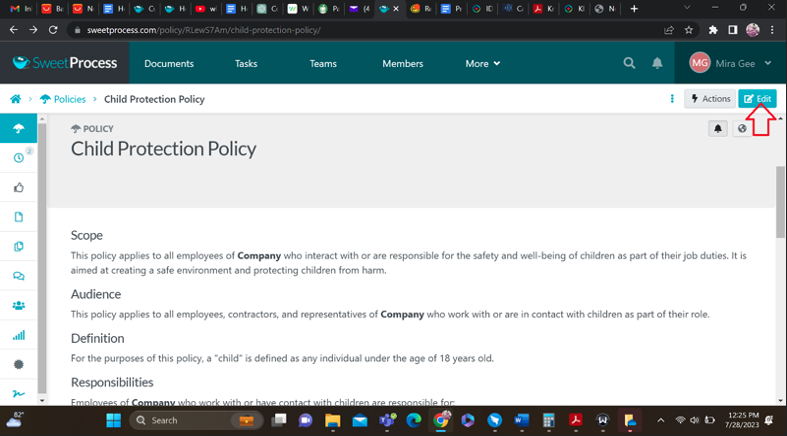
Step 3: Click on the “Actions” tab on the top right corner of your screen if you intend to perform other actions
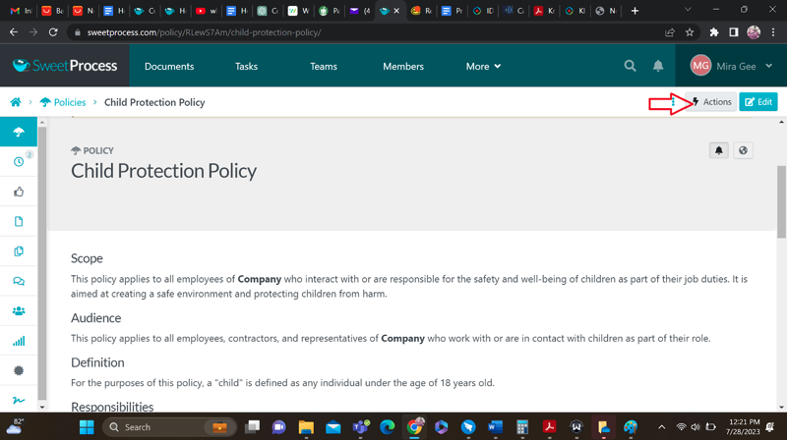
Step 3: Select from the drop-down the action you wish to perform
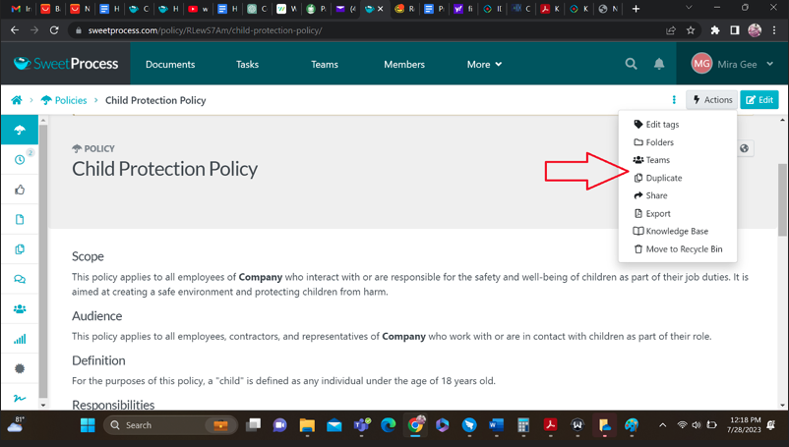
You may edit tags, add to folders, teams, or export.

Some of SweetProcess’s customers have expressed satisfaction with using SweetProcess to create, implement, and manage policies. Notable among them are as follows.
TechQuarters, a dynamic technology solutions provider, recognized the challenges posed by tribal knowledge within its organization. Tribal knowledge refers to information and expertise known to only a few individuals, making it difficult to share and retain vital information across the team. TechQuarters implemented SweetProcess, a powerful process documentation and management tool, to address this issue and enhance operational efficiency.
Using SweetProcess, TechQuarters successfully eliminated the reliance on tribal knowledge and created a more organized, efficient, and collaborative work environment. They now enjoy seamless policy documentation and sharing. The company empowered its team members with the information they needed to excel in their roles, resulting in increased productivity, enhanced knowledge retention, and improved overall performance.
Clients have continuously achieved tremendous results with SweetProcess. Another such client is Michel Coutu, the president of Location Accès Crédit. Location Accès Crédit helps clients access vehicle loans in Canada. Michel needed help with his employees following stipulated work policies. His major pain point was the need for more documentation. His employees needed help accessing work-related policies.
In his search for a solution, he found SweetProcess, where he could document his policies and ensure adherence. Since then, Location Accès Crédit has enjoyed standardized business operations, seamless employee onboarding and training, and remote access to work documents.
Next7 IT, a leading IT services company, recognized the need for greater consistency in its operations to deliver top-notch services and solutions to its clients. Next7 IT implemented SweetProcess to address this challenge and streamline its processes. By leveraging SweetProcess, the company achieved significant improvements in consistency throughout its operations.
In summary, Next7 IT achieved greater operational consistency by leveraging SweetProcess as a powerful process management tool. The platform helped the company standardize procedures, improve communication, enhance collaboration, and optimize performance, ultimately leading to more reliable and exceptional service delivery for its clients.
To experience seamless workflow and manage your policies effectively, sign up for a 14-day free trial to learn more about our services.
Writing a policy has some benefits as well as drawbacks you should know. This section discusses the pros and cons of policy writing, arranged in no particular order.
Clarity and Consistency: Policies generally provide crystal-clear guidelines or rules that help ensure consistency when making crucial decisions or taking certain actions within an organization. When everyone knows and follows the policies, it reduces confusion and promotes a unified approach to various issues.
Legal Compliance: Well-written policies help organizations comply with legal and regulatory requirements. They can address specific legal obligations, industry standards, and ethical considerations, reducing the risk of legal disputes and penalties.
Risk Management: Policies help mitigate potential hazards, making them essential for managing risks within a business establishment. They typically cover several areas: security, safety, financial, and data protection. They also help prevent adverse events.
Accountability and Transparency: Policies set the expectations and standards for an organization’s responsibilities, roles, and behavior. They excellently promote accountability among employees while ensuring transparency in every decision-making process.
Efficient Decision-Making: Policies establish a pretty solid framework for decision-making. Managers, as well as employees, make quick and highly informed choices confidently using policies.
Employee Guidance: Policies provide workers with a reference point for their benefits, rights, and obligations within the company. They can address issues like leave policies, performance evaluations, and grievance procedures, helping to create a positive and supportive work environment.
Organizational Culture: Policies can reflect the organization’s values and promote a positive culture. They support diversity and inclusion efforts, ethical conduct, and other initiatives that align with the organization’s mission and vision.
Resource Allocation: Policies can help allocate resources effectively by defining priorities and providing guidelines for resource distribution. This ensures that resources are utilized productively and strategically.
Conflict Resolution: When conflicts arise within an organization, policies are the reference point for resolving all disputes objectively and impartially. This prevents favoritism or bias during decision-making.
Adaptability and Growth: Policies are generally not set in concrete or stone. They evolve as the organization expands or grows over time. Regularly reviewing and updating policies allows organizations to adapt to new challenges and opportunities.
Stakeholder Confidence: Policies enhance the utmost confidence of company stakeholders, such as partners, investors, and customers, as they demonstrate that the organization functions with structured and responsible approaches.
Policy writing has its share of challenges. Some of the cons of policy writing include the following:
Complexity and Length: Policies often require detailed explanations and can be lengthy, leading to potential confusion for employees or stakeholders needing help understanding the policy’s intricacies.
Bureaucracy: The policy development process can be bureaucratic and time-consuming. Multiple levels of approval, revisions, and consultations may slow down the implementation of necessary policies.
Lack of Clarity: Poorly written policies may result in confusion, misinterpretation, and ineffective implementation, undermining the policy’s goals.
Resistance to Change: Employees may resist new policies, especially if they perceive them as burdensome or constraining. Resistance can hinder effective implementation and adherence.

The policymaker has several key responsibilities to ensure the effective implementation and adherence to organizational policies. These responsibilities are crucial for maintaining a compliant working environment.
Here are the primary duties of policy owners:
Policy Development: Policy owners are accountable for creating and formulating new or updated policies. They must conduct thorough research, gather relevant information, and involve relevant stakeholders to ensure policies are comprehensive and aligned with the organization’s goals.
Policy Communication: Policy owners are responsible for effectively communicating policies to all relevant parties. They must ensure employees understand the policies, purpose, and implications. Clear communication helps minimize misunderstandings and ensures consistent adherence throughout the organization.
Implementation: Policy owners play a pivotal role in implementing policies effectively. They must collaborate with various departments to seamlessly integrate policies into their workflows and operations.
Compliance Monitoring: Regularly monitoring policy compliance is crucial to identify deviations or potential issues. Policy owners should establish mechanisms for tracking adherence and conduct periodic reviews to assess the effectiveness of policies.
Training and Education: Policy owners must provide employees with adequate training and educational resources to ensure successful implementation. This helps raise policy awareness and equips staff members with the knowledge and skills to follow them.
Documentation: Properly documenting policies, their development process, and any changes made are essential. Policy owners should maintain comprehensive records to track the policy lifecycle and facilitate auditing and reporting.
Revisions and Updates: Policies should be revised and updated over time. This is essential so they reflect the prevailing changes in organizational requirements. Policy owners should go through them regularly. If needed, give those policies a little shake-up to match the latest trends and changes.

Policy writing is crucial to any organization or business. To start writing policies, here are some significant do’s and don’ts, including things you should consider before writing your organization’s policy.